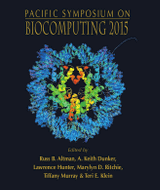
Benjamin M. Good, Max Nanis, Chunlei Wu, Andrew I. Su
Molecular and Experimental Medicine, The Scripps Research Institute
Email: bgood@scripps.edu, max@maxnanis.com, cwu@scripps.edu, asu@scripps.edu
Pacific Symposium on Biocomputing 20:282-293(2015)
Identifying concepts and relationships in biomedical text enables knowledge to be applied in computational analyses. Many biological natural language processing (BioNLP) projects attempt to address this challenge, but the state of the art still leaves much room for improvement. Progress in BioNLP research depends on large, annotated corpora for evaluating information extraction systems and training machine learning models. Traditionally, such corpora are created by small numbers of expert annotators often working over extended periods of time. Recent studies have shown that workers on microtask crowdsourcing platforms such as Amazon’s Mechanical Turk (AMT) can, in aggregate, generate high-quality annotations of biomedical text. Here, we investigated the use of the AMT in capturing disease mentions in PubMed abstracts. We used the NCBI Disease corpus as a gold standard for refining and benchmarking our crowdsourcing protocol. After several iterations, we arrived at a protocol that reproduced the annotations of the 593 documents in the ‘training set’ of this gold standard with an overall F measure of 0.872 (precision 0.862, recall 0.883). The output can also be tuned to optimize for precision (max = 0.984 when recall = 0.269) or recall (max = 0.980 when precision = 0.436). Each document was completed by 15 workers, and their annotations were merged based on a simple voting method. In total 145 workers combined to complete all 593 documents in the span of 9 days at a cost of $.066 per abstract per worker. The quality of the annotations, as judged with the F measure, increases with the number of workers assigned to each task; however minimal performance gains were observed beyond 8 workers per task. These results add further evidence that microtask crowdsourcing can be a valuable tool for generating well-annotated corpora in BioNLP. Data produced for this analysis are available at http://figshare.com/articles/Disease_Mention_Annotation_with_Mechanical_Turk/1126402.